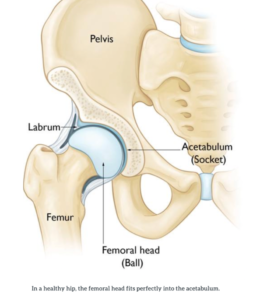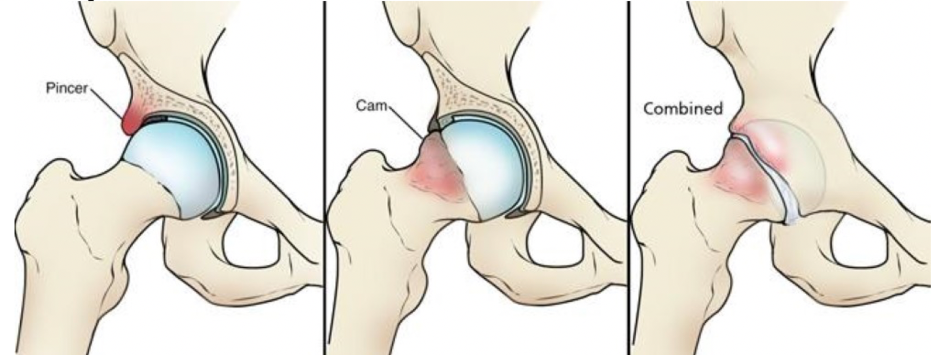What is Causing My Hip Pain?
Hip pain can be due to a number of causes. This can range from simple tendonitis from overuse to osteoarthritis, which is a wearing down of the cartilage in the hip joint (typically seen in patients over the age of 50). In between this spectrum of causes however is a condition called femoroacetabular impingement or FAI. This problem is typically seen in younger, athletic people such as those involved in football, soccer, or basketball, but is not uncommonly seen in dancers, gymnasts, and other sports that require increased flexibility. Although it is seen in these athletes, due to its cause it can also be seen in individuals who are not involved in competitive sports as well.
What causes FAI?

Photo Credit: orthoinfo.aas.org
In simple terms, FAI, or femoroacetabular impingement, is caused by abnormal anatomy on the femur bone (ball) or on the acetabulum (socket) although it is commonly both that are abnormal. Femoroacetabular impingement is a medical condition in which extra bone grows along the bones that form the hip joint. The extra growth means the bones do not fit together as well as they should, with the bones rubbing against each other during movement. The friction caused by the bone rubbing together can, over time, can damage the joint and limit physical activity due to the pain. The ball-and-socket joint of the hip allows for great range of motion such as when you kick a ball or when you’re doing a deep squat. However, if the shape of the ball, the socket, or both, are abnormal then impingement can occur due to the ball hitting the socket in an abnormal location. When the abnormal bone is on the femur, we call this a “Cam” type of FAI. When the abnormal bone is on the acetabulum, we call this a “Pincer” type of femoroacetabular impingement (FAI) . It is referred to as a “Combined” type if both are present.
There are three types of FAI: pincer, cam, and combined impingement.

Photo Credit: orthoinfo.aas.org
How Do I Know If I Have FAI?
Typically, patients with FAI will present to their physician with hip pain that is worth with activity, deep squats, and after increased activity. Patients may also experience stiffness and notice a limp on the affected side. During your visit with your surgeon he/she may perform physical exam maneuvers of the hip to elicit where the pain is coming from. This helps him/her diagnose the cause of the pain.
Your physician may use x-rays to make evaluate the ball and socket joint of the hip and to make measurements of the bones to determine the degree of abnormality seen at the hip joint (if it is present). Furthermore, if an FAI is present and your hip pain is severe your physician or surgeon may order an MRI to evaluate the labrum, which is the soft cushion around the outside of the socket to see if this is torn due to the FAI. The MRI also allows evaluation of other structures such as the cartilage and soft tissue around the hip. In certain situations, your physician may put a numbing medication, with a needle, into your hip joint to see if this alleviates your pain. This is a good way to confirm the suspicion of the diagnosis if your hip pain is alleviated with the hip injection.
Do I Need Surgery?
The need for surgery depends on several factors. In most cases, if this is the first time you are being seen for FAI, we usually recommend non-operative treatment. Non-operative treatment typically involves physical therapy and we may need to limit some of your activities for a short period of time to rest your injured hip. Physical therapy will evaluate you and work with you on exercises, stretches, and modalities that will help increase the health of your hip joint.
If you have tried physical therapy, modified your activities for a period of time, and are still having pain and discomfort, you may need surgery to correct the FAI and address issues such as labrum tears and/or damaged cartilage. This is a discussion that you should have with your surgeon and will involve discussing the risks and benefits of surgery, the timing of the surgery, and when the best time is to have surgery if you have other obligations such as school, sports, or work.
What Is It Like After Surgery?
After surgery you will typically go home that day. For the first 3-5 days your hip will be sore and a bit swollen from the surgery. During this time you will be applying ice to your hip and will need to take pain medications as needed for the first 3-5 days. You will be able to walk with crutches putting some weight on your leg immediately. You will be using either a bike or a CPM machine to start moving your hip early so that it doesn’t get tight after your operation. You will also start physical therapy during the first week to start working on range of motion and strengthening your leg after surgery and to make sure you keep your normal range of motion.
Can I Go Back to Sports After Surgery?

Photo Credit: BroncoSports.com
The goal would be to get you to return to your previous sport at your previous level. The post-operative rehabilitation process will be key to getting your knee reconditioned to return to your sport. A typical timeframe to achieve a return to sport is 12-16 weeks depending on the sport you play.
When Do I Seek Further Evaluation?
If you have had hip pain that seems to be getting worse and or simply not getting any better, you should see a Sports Medicine trained physician not only to assess the injury but to prevent further injury to your hip. A thorough evaluation and discussion of your treatment options should be made by you, your parents (if you are less than 18), and your trainer/coach (if you are an athlete).
To set up an appointment for further evaluation, please call (208) 336-8250.